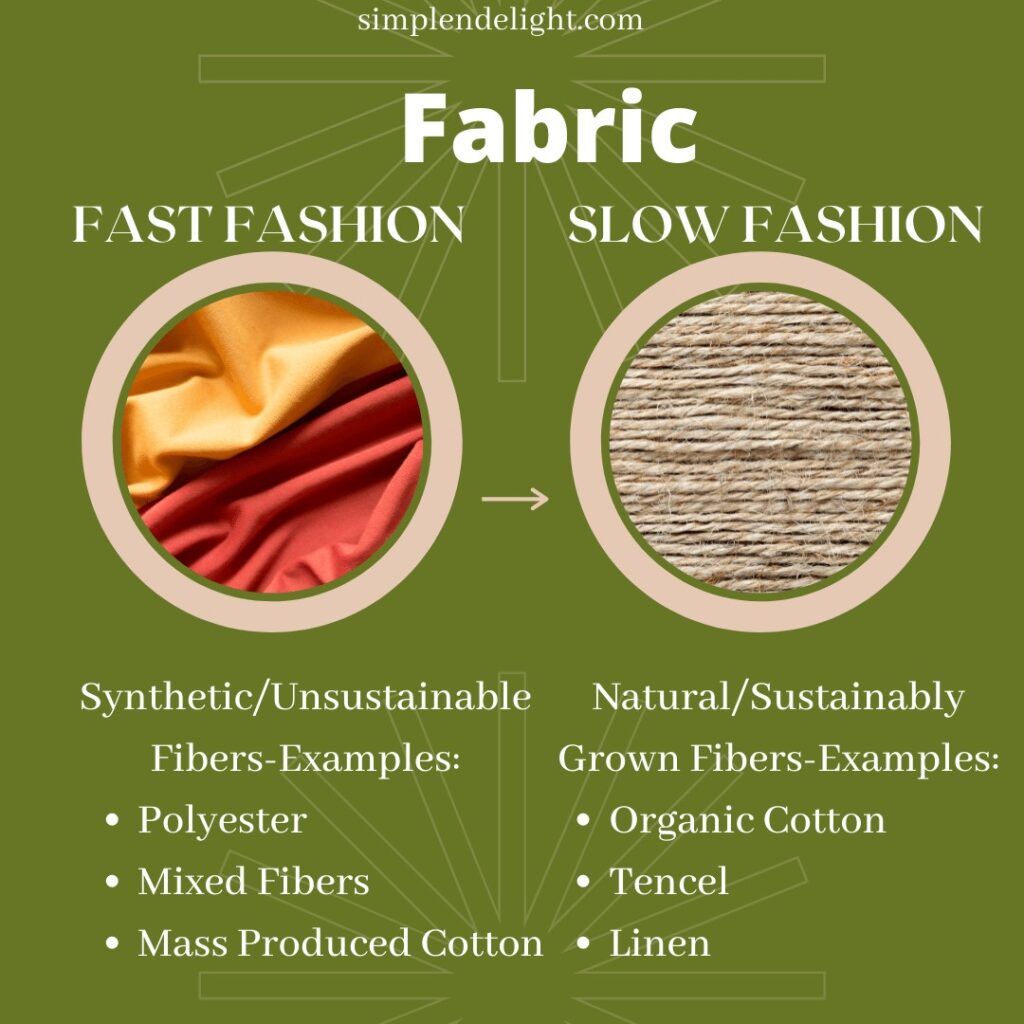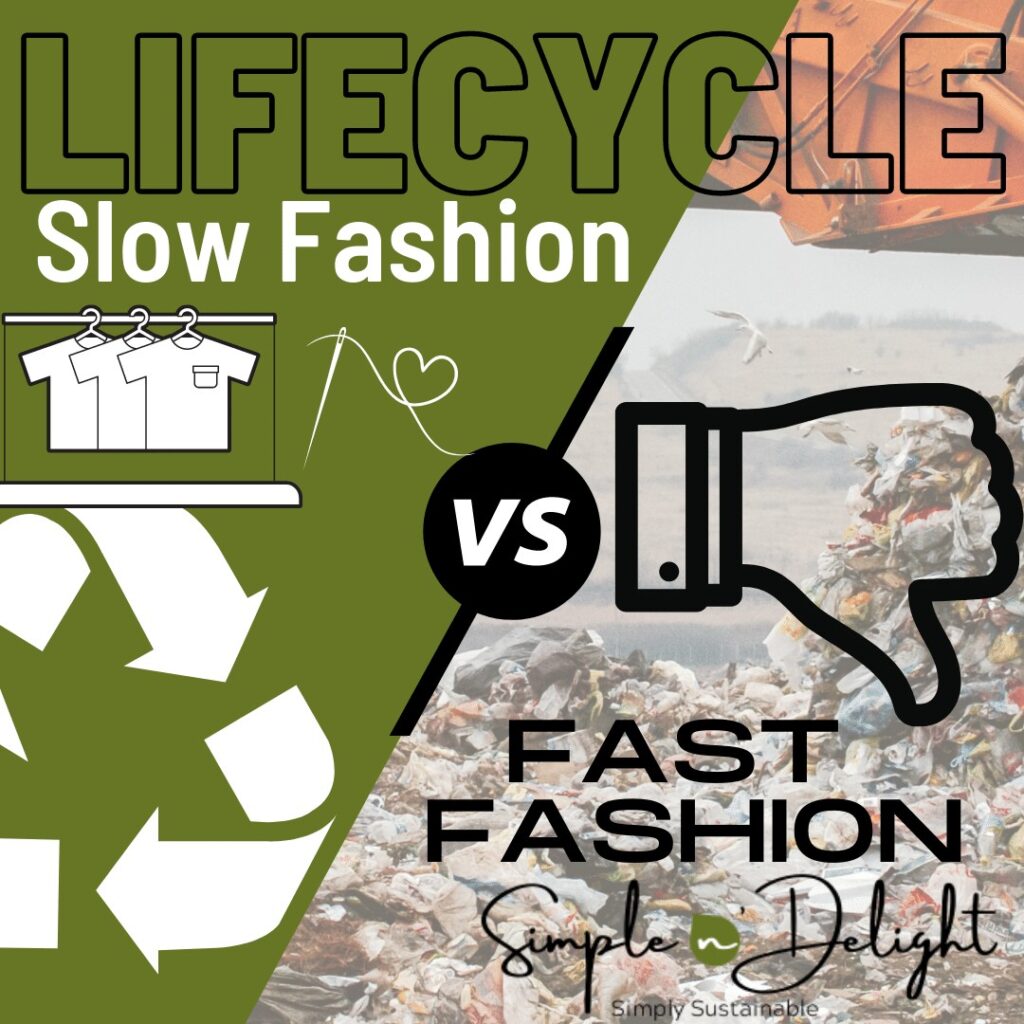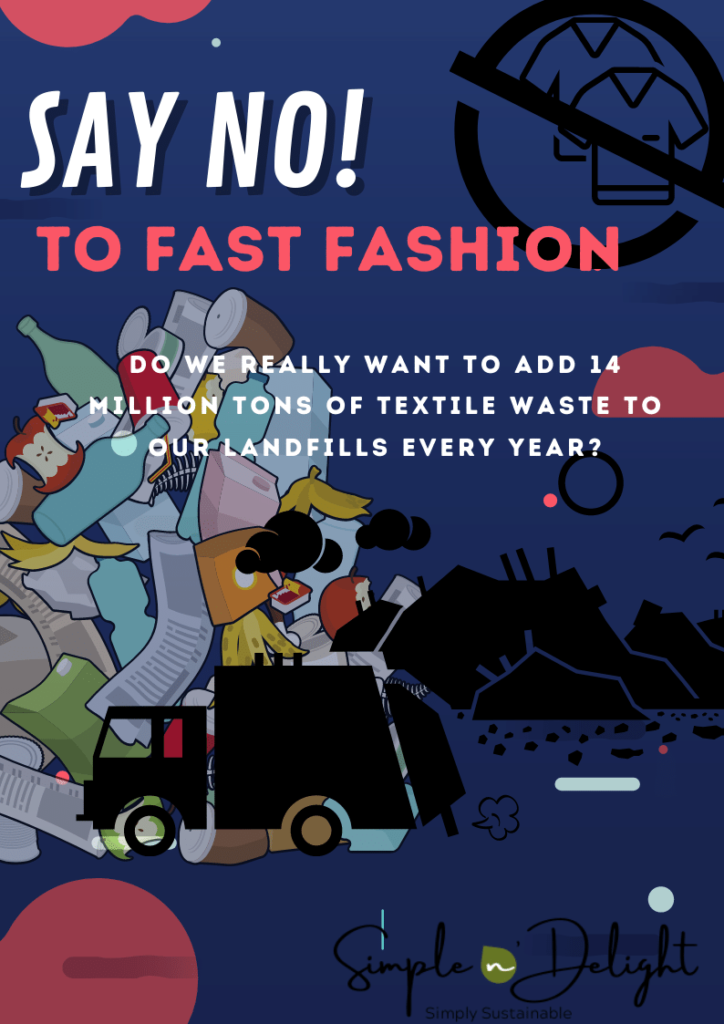Fast fashion vs slow fashion, what’s the difference!?
Fast fashion is the ability to be able to buy new, lower-quality clothing, more often at low prices. Garments often end up in landfills and come with a plethora of hidden environmental and social costs. Slow fashion is much the opposite.
Slow fashion aims to go back to the way we used to consume clothing. Slow fashion is about owning only a few, well-made, fashionably versatile items. Slow fashion has much fewer eco-impacts than fast fashion and is more sustainable in the long term.
This post may contain affiliate links, which means that I may earn a small commission if you make a purchase using these links. As an Amazon Associate, I earn from qualifying purchases.
Here are the top differences between fast fashion vs slow fashion:
1. Fast Fashion vs Slow Fashion: Fabrics

One of the immediate differences you will notice when you pick up a garment made from the slow-fashion industry are the fibers. Fast fashion vs sustainable fashion uses synthetic, man-made fibers, such as polyester, spandex, acrylic, and nylon. Fast fashion also uses mass produced, chemically sprayed cotton.
Unfortunately, most fast-fashion fibres use fossil fuels in production. This contributes to the increase in greenhouse gases and environmental pollution. New clothing made in the slow-fashion mode often uses more sustainable fabrics. Organic cotton, Tencel, linen, and hemp are among some of the fabrics used. These fabrics can sustain more washes, and emit less CO2 during cultivation and production. To learn about brands that are currently using recycled fabrics in the production of their clothing, read 35 Recycled Clothing Brands Making a Change for a Greener Future.
If you would like to learn how to wear clothing more sustainably click here.
2. Fast Fashion vs Slow Fashion: People

The fast fashion industry’s foundation is built on the ability to employ a large number of people for a very small cost. The majority of all fast fashion is manufactured in countries such as Bangladesh, Cambodia, and Indonesia. Fast fashion vs sustainable fashion companies take advantage of poor labor laws. These developing countries pay minimal wages to workers. Human exploitation is a huge problem within the fast fashion industry.
Slow fashion is often made in already developed nations such as the USA, Canada, and European countries. A pillar of slow fashion is to pay workers fair and equitable rates.
3. Fast fashion vs Slow Fashion: Store Fronts

Fast fashion vs sustainable fashion brands are usually located in large stores. The Gap, Old Navy, H&M, Forever 21, Zara, and more, are often found in malls and have huge selections for every season. Turnover is quick. If you love these clothes, try finding them at your local thrift shop in order to lower the environmental footprint. For a list of online thrift stores take a look at our article: How to Find the Best Second-Hand Clothes Online Thrift Stores Worldwide.
Slow-fashion brands are often paired with other sustainable brands in more boutique shops or have complete stores online, making them even more green. Some examples of slow fashion brands include: Organic Basics, Kotn, Coyuchi, Urban Kissed, and more. Whether in a mall or on street entrances, slow fashion is often sold in smaller stores. They emphasize quality over quantity. Stores selling used clothing can also be considered slow-fashion.
4. Fast Fashion vs Slow Fashion: Lifecycle

Clothing coming out of the fast fashion industry has a very short life cycle. Clothing is often made for seasonal use. Clothes develop rips, holes, tears, or loose stitches due to the inferior quality of fabric and manufacturing. The majority of fast fashion ends up in landfill every year.
One of the main philosophies with slow fashion is that clothing is made to last years. Fabrics are more durable and withstand modern washing and drying practices. Styles are more versatile through the years and are not identified within a fashion trend.
5. Fast Fashion vs Slow Fashion: Sustainability

Garments made within the fast fashion industry lack sustainability on many fronts. From the extraction of fossil fuels to the lack of sustainable wages for workers to the longevity of a garment, fast-fashion fails on all accounts. Slow fashion is made of fabrics that have the lowest environmental footprint possible. Often made from recycled cotton, Tencel, organic hemp, and organic linen. These fabrics aim to limit the use of water, pesticides, and nonrenewable resources in their production. Sustainable clothes also mean sustainable wages for workers, and longevity of wear.
6. Fast Fashion vs Slow Fashion: Cost
Yes, fast fashion is cheaper than slow fashion at the cash register, but the real costs are seen in years to come. The cost of using nonrenewable resources, the cost of cheap human labor, and the cost of waste in the landfills, are only a few of the many taxes this industry puts on the earth. These are costs which we will pay for generations to come.
The cost of slow fashion is upfront. We pay a fair price for the materials used, the labor expended, and the longevity of the garment. For most of us, the cost of slow fashion is a hard pill to swallow. There are other ways to lower the cost of fashion. Adopting a minimalist capsule wardrobe, shopping second-hand, and saving up for quality items. Changing your habits is the key!
7. Fast Fashion vs Slow Fashion: Quality
Quality is one of the biggest differences you will notice immediately when switching from fast to slow fashion. Fast fashion vs sustainable fashion is constantly looking to cut corners and reduce costs to keep prices low. Ever wonder why the t-shirt you bought at H&M ten years ago is actually still alive? Well, that is because even 10 years ago, companies used to use better, thicker, and more sustainable fabrics. Fabrics used in slow fashion are made to last, withstand washes, and are easily mendable and repairable.
8. Fast Fashion vs Slow Fashion: Microplastics
The fabrics used in fast fashion are often blends of synthetic materials. These blends often release microplastics into our waters. We do not yet have the technology to trap these microscopic fibers. As a result, they end up in our waters, getting eaten by marine life. Ever eat fish? Well, it is known that humans can eat up to a credit card worth of plastics in a week by contaminated sources. This is largely due to microplastics from our clothing. The easiest way to avoid microplastics contaminating the water is to get a Guppyfriend Bag which traps some of the microplastics in the bag rather than in the water.
The natural fibers used in slow fashion do not break down and pollute our waters. Making small changes towards more sustainable fabrics can have a HUGE impact on our health and environment.
9. Fast Fashion vs Slow Fashion: Pollution
Fast fashion vs slow fashion makes up 10% of our Carbon Emissions. In Bill Gates’ book, “How to Avoid a Climate Disaster”, he details how we have to reduce our carbon emissions by 51 billion tons. This reduction will get us to net-zero emissions. To put this into perspective, the global COVID pandemic only reduced emissions by 5 percent in 2020. Fast fashion is adding to the waste in landfills, carbon emissions, and contaminated waters. Although not entirely innocent, fabrics sold through slow fashion, contribute much less to air, land, and water pollution.
10. Fast Fashion vs Slow Fashion: Consumption
Fast fashion vs sustainable fashion induces consumption. We need to slow it down! People today buy 60% more garments than they did in the year 2000. Fast fashion is about keeping up with the trends. Companies update their collections various times per year. Eighty-five percent of textiles end up in landfills every year. Slow-fashion advocates for keeping garments for longer. Slow fashion is about styles that remain fresh years later and fabrics that can easily be repaired. There is a difference in mentality when you are buying into slow fashion. Minimalist ideals of using only what you need when you need it, are admired.

What Next?
Knowledge is power. Knowing about the environmental and social impacts of fast fashion is a step in the right direction. Fast-fashion companies are successful because people buy their clothes. The less they sell, the more they will get the message to change. Next time you’re in the market for new apparel, try a new brand or try to source the item second-hand. Together we can make a difference. Take a look at our other fashion suggestions for more sustainable, safer options to fashion. Or try the Zero Waste Challenge to get you started in the right direction.








3 Responses
Very interesting article. It made me realize there’s lots to learn when it comes to fashion and the clothes we buy and the fast vs slow fashion definitely drew me closer. Kudos!
I’m all about sustainability: let’s hear it for slow fashion!
So many people and brands nowadays are trying to be always trendy, making and buying so much clothes, without even thinking of the impact on the environment. I was one of those people, too. But I realized I don’t need that much to still look and feel good. Thank you for sharing and spreading the message 🙂